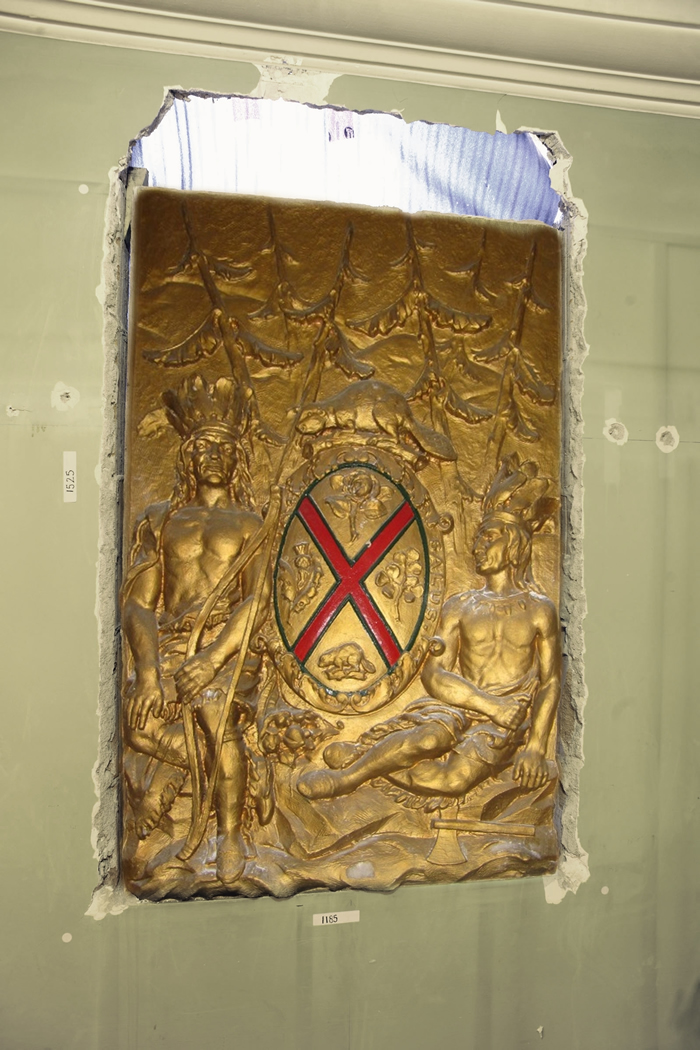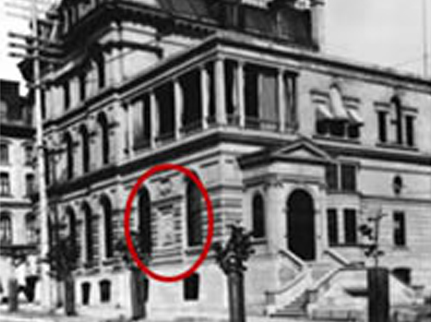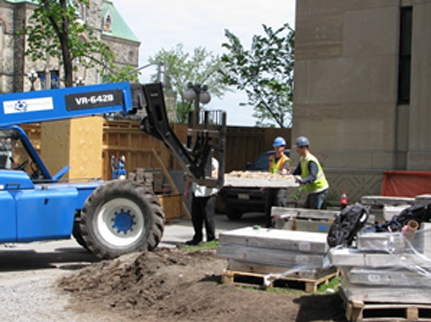Historic stone carving uncovered in the Sir John A. Macdonald Building

The sculpture discovered within the walls of the annex of the Sir John A. Macdonald Building.
As part of the work underway to rehabilitate the Sir John A. Macdonald Building, an interesting discovery was made on the construction site. A historic stone carving was uncovered within the existing walls of the former Bank of Montreal building. The sculpture, depicting the coat of arms of the Bank of Montreal, was discovered by workers removing marble panels and drywall in the annex in this important heritage building.
The sculpture features the Bank of Montreal’s coat of arms and motto, Concordia Salus, which is located in the centre of the work and means “prosperity through harmony.” The Bank of Montreal coat of arms is surmounted by the symbol of Canadian industriousness, the beaver. The crest is supported by two Aboriginal people, and in the background, in low relief, are pine trees. The sculpture is carved from Berea sandstone and measures 1.1 metres by 1.5 metres. The surface of the stone is coated in a bronze coloured paint with green and red details with a bright gold coloured paint underneath.

An archival photo of the original Bank of
Montreal building, with an addition
constructed at a later date. The tablet
was set in the front entrance of the
addition.
Credit: William James Topley/Library
and Archives Canada/PA-008955

Removal of the sculpture from the wall of the building.
The sculpture will be secured in the foam-lined crate
and put into storage, where it will be catalogued.
There is no indication of the sculptor’s name and information about the origin of the tablet is limited. The original Bank of Montreal building was constructed in 1872 and a two-storey annex was built at a later date. The style of the carving suggests that it came from the same period and according to an archival photo, a large stone tablet, similar to the one found, was set into the façade of that addition. The current building located at 144 Wellington Street was built in the early 1930s and replaced the original structure from 1872. Evidence, such as the surrounding masonry, suggests that the tablet was moved from the 1872 building and installed in the current building during its construction in the early 1930s. Several other sculptures depicting the coat of arms can still be seen today on the exterior of the Sir John A. Macdonald Building.
The tablet was uncovered by workers as part of the preparation required for the construction of the future addition. In order for the work to continue the stone carving had to be removed from its location and consultants and experts from Public Works and Government Services Canada’s Heritage Conservation Directorate were called onto the site to document the discovery and make recommendations for its protection and removal. In the days following the discovery the stone was removed by stonemasons and carefully crated and moved into storage to preserve this interesting piece of history.
Public Works and Government Services Canada is considering options to showcase the newly discovered sculpture as a decorative piece in the rehabilitated building or at alternative sites.
The Modernization of Sir John A. Macdonald Building involves an extensive renovation to the building to permanently house the West Block’s Confederation Room (Room 200), and the construction of an addition in the courtyard located to the west of the building. The addition will provide meeting rooms, a secure entrance for guests of the facility, and essential support functions for the facility, including a loading dock, mechanical rooms, food services, and washrooms.
- Date modified: